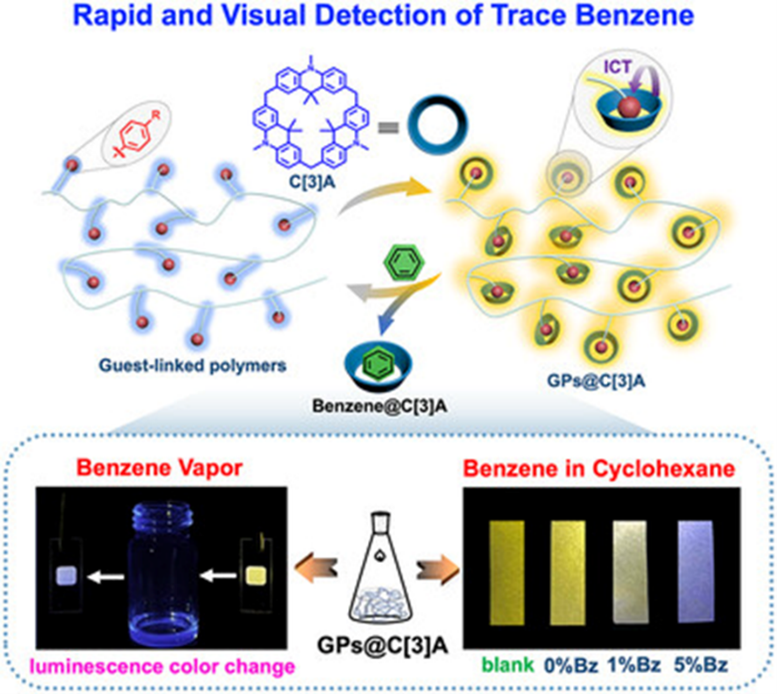Benzene is one of the most hazardous volatile organic compounds (VOCs), widely used in industry and prone to accumulating in the environment. Conventional benzene detection methods, such as chromatographic techniques, are expensive and require specialized equipment and skilled operators, which limit their applicability for real-time or field-based monitoring. On the other hand, emerging real-time sensors have been developed that can detect target molecules through luminescence changes mediated by host–guest interactions. However, the development of such a benzene detector remains challenging due to its low reactivity and low polarity.
A new supramolecular strategy has been developed by Chen and co-workers for the rapid and visual detection of trace benzene vapor using supramolecular thermally activated delayed fluorescence (STADF) polymeric materials, based on a luminescence change mechanism. This breakthrough uses a unique host–guest system formed between calix[3]acridan (C[3]A) and guest-linked polymers (GPs) to produce tunable, multicolor luminescent materials, GPs@C[3]A. The luminescence color of GPs@C[3]A can be controlled by adjusting the proportion of C[3]A. White luminescent GP1@C[3]A was obtained by incorporating a 20 mol% ratio of C[3]A into GP1. This design utilizes the high selectivity of the macrocyclic host C[3]A for benzene compared to other guest molecules. This complexation induces a noticeable luminescence color change by suppressing intermolecular charge transfer (ICT) interactions between the macrocyclic donor and acceptor guests. Upon exposure to benzene, GP1@C[3]A enables naked-eye detection of benzene vapor within seconds, achieving a limit of detection (LOD) as low as 3.5 mg L⁻¹, making it a strong candidate for practical sensing applications. The STADF materials were further fabricated into paper-based sensor strips, offering a convenient and portable solution for benzene detection in cyclohexane.
This study demonstrates a pioneering application of STADF materials for benzene detection and showcases their potential for real-time, visual environmental monitoring.
- Supramolecular TADF Materials from Calix[3]Acridan and Guest-Linked Polymers for Rapid and Visual Detection of Trace Benzene
Ying Han, Kui-Zhu Song, Yu-Jie Long, Wei-Chen Guo, Ming-Jun Ji, Xiao-Ni Han, and Chuan-Feng Chen
Angew. Chem. Int. Ed. 2025
doi.org/10.1002/anie.202508987



